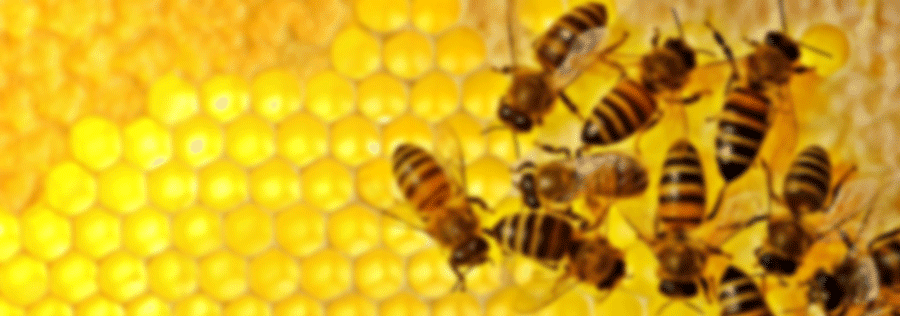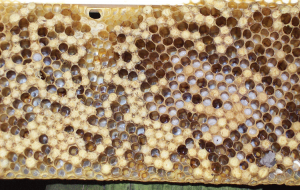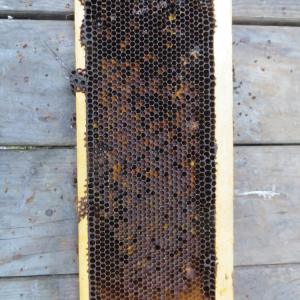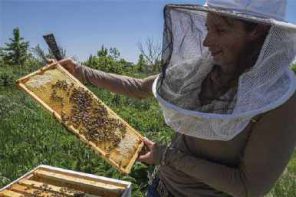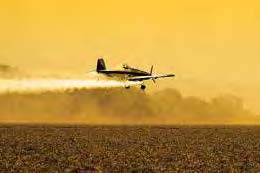By: Ross Conrad
My typical Winter losses over the last decade have tended to hover between 10-18%. Not ideal, but far better than what most other beekeepers have been reporting. It seems that by combining the five management techniques as I have outlined in previous articles (good genetics, screened bottom boards, breaks in the brood cycle, rotating old comb out of the hive, and culling capped drone brood) I am usually able to keep Varroa related stresses low enough that the bees are generally able to cope with the other stresses in their lives and survive – for the most part.
This was a tough winter for my bees here in Vermont. At 43 percent, I had to go all the way back through my records over 15 years to 2000 before finding Winter losses in my apiary that high or higher (78% loss in 1998, 72% loss in 2000, 36% loss in 2002).
I don’t mean to be complaining here. According to the Bee Informed Partnership yearly surveys, losses of 30-40 percent are common these days for many beekeepers – it’s just that they have not been common for me. While it appears that there is a working formula for those who don’t want to treat their colonies with chemicals or drugs in these days of Colony Collapse and Neonicotinoid pesticides, apparently I became rather lax in my hive management diligence for this Winter I received a rude awakening.
“I have longed believed that when a colony perishes, it is given as a gift to the beekeeper in the form of a lesson learned.”
Turning Lemons into Lemon-Aid
When a hive dies it is the perfect time to remove all the frames and scrape clean all the burr comb and propolis that has built up on the hive surfaces that make it difficult to manipulate the frames within the supers. Although cleaning up dead hives has got to be the least enjoyable part of beekeeping, I have dutifully applied myself to the task. In the process I have found that a lot of the combs in my hives were not as new as I had thought. Due to chronic equipment shortages I have been pushing the standard three to five year rotation rule for old comb and have apparently arrived at the point where much of my comb is in the five to eight year old range (at least in the majority of my hives that died out this Winter).
I have also been lax about the culling of drone comb to remove mites reproducing in the capped brood. I had settled on a hit or miss approach, pulling frames of drone comb as I happened to come across them rather than working in a systematic manner culling drone brood on a regular and consistent cycle. My previous overwintering success had given me a false sense of security so I never felt like it was important to take the extra time to be more intentional about my culling.
The Exception
There is a dearth of research into the kind of physical and cultural management techniques that I use to control Varroa mite related stress on honey bee colonies and so last year I decided to address this lack of data thanks to partial funding I received from the USDA Sustainable Agriculture Research and Education (SARE) Program. As part of this grant funded study, I set up a bee yard in which the Mite Away Quick Strip (MAQS) formic acid treatment is the only mite control used on about half the colonies. The other half of the colonies in the same bee yard are being intensively managed using the five management techniques mentioned above. It is interesting that this is the only beeyard that did well this winter with 21 out of 22 colonies surviving Winter. Conversely, my control yard located about ¾ of a mile away from the treatment yard saw only six out of 14 hives survive the Winter.
That’s not to say that the hives that died this Winter all perished as a result of the mites. A number of colonies clearly went queenless and become drone layers during the Winter. However, late Summer mite counts had indicated that the level of mites in the MAQS treated colonies was very similar to the mite levels found in the colonies that received all five of the intensive management techniques. Clearly, adequate mite control (or should I say inadequate mite control) was an important factor in this year’s winter losses here in the Champlain Valley of Vermont.
However as noted above, I have gotten a bit lackadaisical in my efforts to control mites using only management techniques. Even though I have used these management techniques for many years, it had always seemed to work previously. The big question in my mind is ‘what was different about this year?’
Climate Destabilization
The only logical answer that I am able to come up with is the weather. This Winter was one of the most inconsistent Winters, in terms of weather, that I can recall in a very long time. Here in Vermont, the season started late and instead of the usual two-three day January thaw, we had a two-week thaw in January – then the really cold weather hit. Then it got warm, then cold, then warm, then cold, then warm, then the big snows finally came right at the end of winter and early spring.
Ideally for the bees, the weather would get gradually cold, and remain cold for a while, before getting gradually warm. This gives the bees time to get their cluster organized. Dramatic and rapid shifts in temperature can catch the bees off-guard and prevent them from organizing into a single cluster that maximizes their chances for survival. The best a bunch of bees can do when they get caught out of the cluster as the temperature drops is to form a second, or third cluster. The warmer-than-normal temperatures also can create a false sense of spring, leading the bees to use up a lot of resources building up their population at the wrong time of year. None of this is ideal.
Time To Up My Game
I have long believed that when your colonies die, they are giving you a gift – the opportunity to become a better beekeeper. By figuring out why the bees died and then taking appropriate steps to change one’s honey bee husbandry so the same situation does not happen again, one eventually, over time, becomes a good beekeeper.
I can assure you that this year I am going to be much more diligent about getting the combs that are over five years old out of my operation. Sure there will be a reduction in my honey crop as the bees use up their honey to build new comb, but if I stay focused on the improved Winter survival I should see next year, and all the extra beeswax I will have to sell, I should be able to stay the course.
This is also the year that I am going to get serious about culling drone comb. Last year in the hives involved in the SARE trial, I culled frames that had been fitted with drone comb foundation. This was both time consuming (because it includes building the frames and fitting them with foundation several times during the season for each hive) and expensive. This year I am simply going to replace a deep frame in every brood nest with a shallow frame. During regular inspections when I catch the capped drone brood before it hatches in the drone comb the bees will build below the shallow frames, I will simply scape off the drone comb into my wax box and put the frame back in place for the bees to build more drone comb. Once again, the vision of healthier bees in Spring and the additional wax I am producing will be my focus to keep me from becoming demoralized from all the extra time my apiary inspections are going to take.
Looking to the Future
In order to get solid data for this SARE study, I plan on running the trial for a full three years. This will not only provide the opportunity for me to be able to see if the results are reproducible, but will allow me to evaluate the long-term survival of hives that are not treated but instead intensively managed for Varroa. I hope to be able to report on the future results in these pages.







